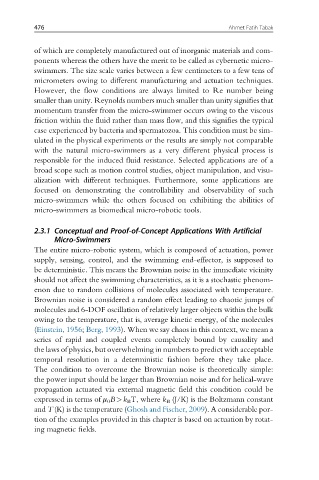Page 482 - Handbook of Biomechatronics
P. 482
476 Ahmet Fatih Tabak
of which are completely manufactured out of inorganic materials and com-
ponents whereas the others have the merit to be called as cybernetic micro-
swimmers. The size scale varies between a few centimeters to a few tens of
micrometers owing to different manufacturing and actuation techniques.
However, the flow conditions are always limited to Re number being
smaller than unity. Reynolds numbers much smaller than unity signifies that
momentum transfer from the micro-swimmer occurs owing to the viscous
friction within the fluid rather than mass flow, and this signifies the typical
case experienced by bacteria and spermatozoa. This condition must be sim-
ulated in the physical experiments or the results are simply not comparable
with the natural micro-swimmers as a very different physical process is
responsible for the induced fluid resistance. Selected applications are of a
broad scope such as motion control studies, object manipulation, and visu-
alization with different techniques. Furthermore, some applications are
focused on demonstrating the controllability and observability of such
micro-swimmers while the others focused on exhibiting the abilities of
micro-swimmers as biomedical micro-robotic tools.
2.3.1 Conceptual and Proof-of-Concept Applications With Artificial
Micro-Swimmers
The entire micro-robotic system, which is composed of actuation, power
supply, sensing, control, and the swimming end-effector, is supposed to
be deterministic. This means the Brownian noise in the immediate vicinity
should not affect the swimming characteristics, as it is a stochastic phenom-
enon due to random collisions of molecules associated with temperature.
Brownian noise is considered a random effect leading to chaotic jumps of
molecules and 6-DOF oscillation of relatively larger objects within the bulk
owing to the temperature, that is, average kinetic energy, of the molecules
(Einstein, 1956; Berg, 1993). When we say chaos in this context, we mean a
series of rapid and coupled events completely bound by causality and
the laws of physics, but overwhelming in numbers to predict with acceptable
temporal resolution in a deterministic fashion before they take place.
The condition to overcome the Brownian noise is theoretically simple:
the power input should be larger than Brownian noise and for helical-wave
propagation actuated via external magnetic field this condition could be
expressed in terms of μ 0 B>k B T, where k B (J/K) is the Boltzmann constant
and T (K) is the temperature (Ghosh and Fischer, 2009). A considerable por-
tion of the examples provided in this chapter is based on actuation by rotat-
ing magnetic fields.

